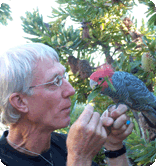Outdoor flight for a Rose-breasted Cockatoo

Hi, I’m planning to build an aviary in the garden of my townhouse in New York City for my rose breasted cockatoo Chirp, so he can spend more time outdoors during the warmer months. The designers have proposed using some type of metal mesh to form the enclosure, and using wrought iron to form some more decorative detail on the outside. What type of material would you recommend for the enclosure (his indoor cage is made of stainless steel), what thickness should the wire be, and how much gap between the wires would be ideal? I imagine that Chirp would get his beak to the decorative metal work made with wrought iron, is that safe? Also, what plants are safe to place inside the aviary? The ground is currently paved with bricks, do you recommend something else? Is there anything else, like pests or other problems, I should be aware of? Thank you so much for your help.

Dear Jade, My compliments on giving your Rose Breasted Cockatoo a new phase in life with an outdoor play cage. Wire choices are many and difficult in the U.S. these days. Stainless steel wire is available but expensive. we used to use high quality galvanized wire from England….Twilweld it was called, but is is rare in the states these days. Some of the local hardware and building wires are Chinese or imported and of poor quality—-one of our main cages rusted all over in four years and had lots of poor galvanizing. You could check with Riverdale Mills on the east coast. http://www.riverdale.com/ ;
For a Rosie I would use half inch by half inch openings in 14 gauge thickness. They are not tremendously strong chewers, preferring to fray things normally. Make sure you bathe the wire down with a vinegar/water solution to remove the zinc that is found on galvanized wire, before finally putting the parrot in the flight. A brick floor may work out, but it is necessary for Rosies to have some sort of applied ground foraging. That either means a section in grasses, wildflowers, seed weeds, and sod where they can scrabble and dig and forage or a large tray from a building center or greenhouse where you can put safe clean sandy soil and plant it or add daily green stuffs (not potting mixes or bagged things, but plain old dirt unsprayed and unfertilized!!) That will give him an area to venture to the ground. The small wire openings will deter most pests, but if you live where there are racoons it can be dangerous. We like to bury a twelve inch section of wire straight out along the ground outside the cage walls and clipped to the walls. That way any rat or cat or such would come up to the wire and try to dig down but only find a wire barrier it cannot dig through.
There are plenty of plants that can be used inside. Google ‘safe plants parrots’ and you will find a list. Our favorites are mulberry, elm, fruit trees including apple, pear, apricot, crabapple, quince. Also all the cluster palms, any bamboos, and hanging plants like spider plants, geraniums, nasturtiums, marigolds, pansies, etc. A sprouting bin will allow you to sprout uneaten bird seeds and place them in hanging orchid baskets for browse. Also cut branches from neighborhood trees allowing pruning will work for weeks fastened by wires high up on the sides of the cage for privacy and perches—maple, oak, beech, evergreens, etc. Anything that would die in the winter needs to be in a large moveable pot to be taken in when frosts begin.You could even get some fresh timothy or alfalfa hay and spread it on the bricks to make cleanup easier every fortnight or so.
A covered roof on part of the aviary is necessary for wind protection and sun screen, and to hide from hawks.. Also a corner or two with plywood on the sides to give privacy so he has a place to hang out and nap.Wrought iron is basically safe, just buy quality paints that are child safe and keep lots of organic chewables and toys he likes in the cage—that will prevent most birds from ever resorting to chewing on wire or paints. A fake playbox (not a total enclosed nestbox) made out of pine shelving would be fun and even some knotted old jeans legs or tee shirts for the cloth fraying rosebreasteds often enjoy.
Good luck and I hope this information is not too late. Your e mail just reached me a short time ago and I know the summer is getting on.
Cheers, EB

































